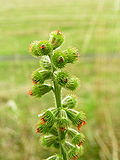Agrimonia eupatoria
Agrimonia eupatoria[edit]

Agrimonia eupatoria, commonly known as agrimony, is a perennial herbaceous plant of the family Rosaceae. It is native to temperate regions of the Northern Hemisphere, including Europe, Asia, and North America.
Description[edit]
Agrimonia eupatoria is a hardy perennial that grows to a height of 30 to 60 cm. The plant has a slender, hairy stem and bears pinnate leaves with serrated edges. The leaves are dark green on the upper side and lighter underneath. The plant produces small, yellow flowers arranged in long, slender spikes. These flowers bloom from June to September.
The fruit of Agrimonia eupatoria is a small, burr-like achene that clings to animal fur and clothing, aiding in seed dispersal.
Habitat[edit]
Agrimonia eupatoria thrives in a variety of habitats, including grasslands, roadsides, and open woodlands. It prefers well-drained soils and can often be found in areas with full sun to partial shade.
Uses[edit]
Historically, Agrimonia eupatoria has been used in traditional medicine for its purported health benefits. It has been employed as a remedy for digestive disorders, sore throats, and skin conditions. The plant contains tannins, which contribute to its astringent properties.
In addition to its medicinal uses, agrimony has been used as a dye plant, producing a yellow dye from its flowers and leaves.
Cultivation[edit]
Agrimonia eupatoria is relatively easy to cultivate. It can be propagated by seed or division. The plant prefers a sunny location with well-drained soil. Once established, it requires minimal maintenance and is drought-tolerant.
Related pages[edit]
Gallery[edit]
-
Agrimonia eupatoria in Keila
-
Close-up of Agrimonia eupatoria flowers
-
Specimen of Agrimonia eupatoria
-
Historical illustration of Agrimonia eupatoria
-
Illustration of Agrimonia eupatoria
-
Agrimonia eupatoria in Keila
-
Agrimonia eupatoria
-
Agrimonia eupatoria specimen
-
Agrimonia eupatoria by Theodore Green
Ad. Transform your life with W8MD's Budget GLP-1 injections from $75


W8MD offers a medical weight loss program to lose weight in Philadelphia. Our physician-supervised medical weight loss provides:
- Weight loss injections in NYC (generic and brand names):
- Zepbound / Mounjaro, Wegovy / Ozempic, Saxenda
- Most insurances accepted or discounted self-pay rates. We will obtain insurance prior authorizations if needed.
- Generic GLP1 weight loss injections from $75 for the starting dose.
- Also offer prescription weight loss medications including Phentermine, Qsymia, Diethylpropion, Contrave etc.
NYC weight loss doctor appointmentsNYC weight loss doctor appointments
Start your NYC weight loss journey today at our NYC medical weight loss and Philadelphia medical weight loss clinics.
- Call 718-946-5500 to lose weight in NYC or for medical weight loss in Philadelphia 215-676-2334.
- Tags:NYC medical weight loss, Philadelphia lose weight Zepbound NYC, Budget GLP1 weight loss injections, Wegovy Philadelphia, Wegovy NYC, Philadelphia medical weight loss, Brookly weight loss and Wegovy NYC
|
WikiMD's Wellness Encyclopedia |
| Let Food Be Thy Medicine Medicine Thy Food - Hippocrates |
Medical Disclaimer: WikiMD is not a substitute for professional medical advice. The information on WikiMD is provided as an information resource only, may be incorrect, outdated or misleading, and is not to be used or relied on for any diagnostic or treatment purposes. Please consult your health care provider before making any healthcare decisions or for guidance about a specific medical condition. WikiMD expressly disclaims responsibility, and shall have no liability, for any damages, loss, injury, or liability whatsoever suffered as a result of your reliance on the information contained in this site. By visiting this site you agree to the foregoing terms and conditions, which may from time to time be changed or supplemented by WikiMD. If you do not agree to the foregoing terms and conditions, you should not enter or use this site. See full disclaimer.
Credits:Most images are courtesy of Wikimedia commons, and templates, categories Wikipedia, licensed under CC BY SA or similar.
Translate this page: - East Asian
中文,
日本,
한국어,
South Asian
हिन्दी,
தமிழ்,
తెలుగు,
Urdu,
ಕನ್ನಡ,
Southeast Asian
Indonesian,
Vietnamese,
Thai,
မြန်မာဘာသာ,
বাংলা
European
español,
Deutsch,
français,
Greek,
português do Brasil,
polski,
română,
русский,
Nederlands,
norsk,
svenska,
suomi,
Italian
Middle Eastern & African
عربى,
Turkish,
Persian,
Hebrew,
Afrikaans,
isiZulu,
Kiswahili,
Other
Bulgarian,
Hungarian,
Czech,
Swedish,
മലയാളം,
मराठी,
ਪੰਜਾਬੀ,
ગુજરાતી,
Portuguese,
Ukrainian




